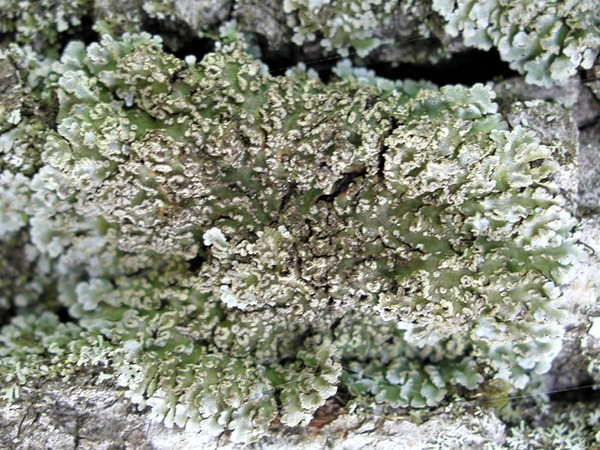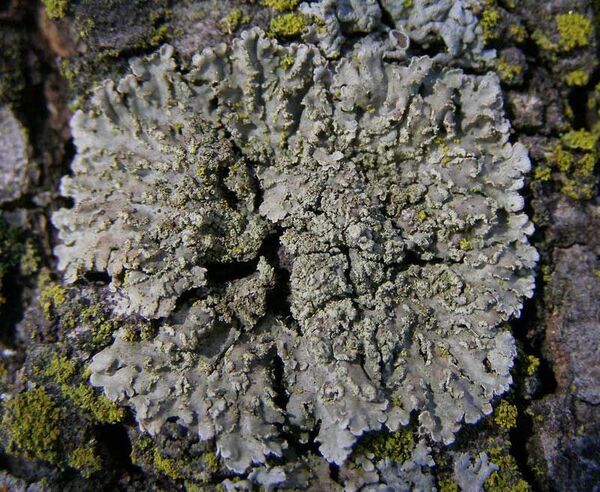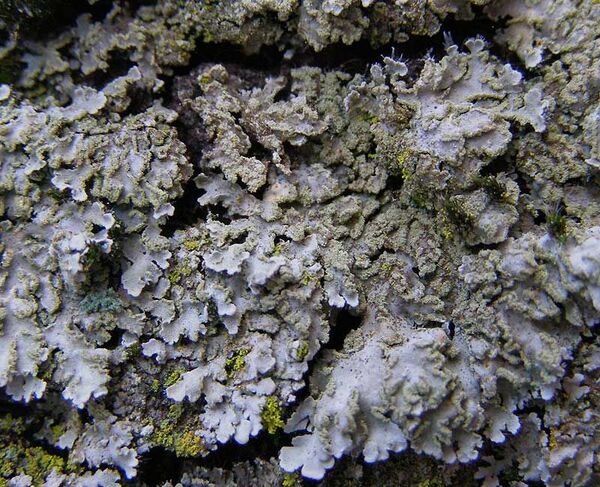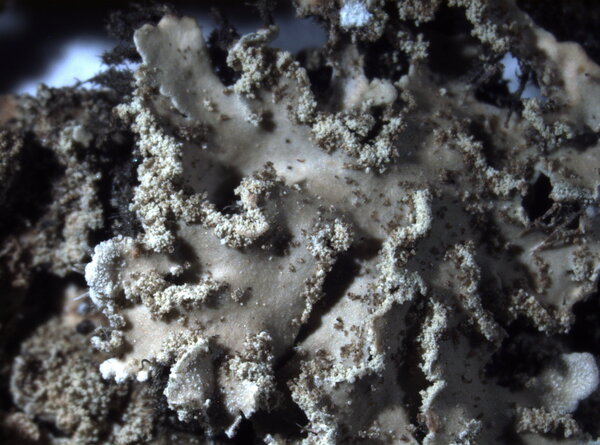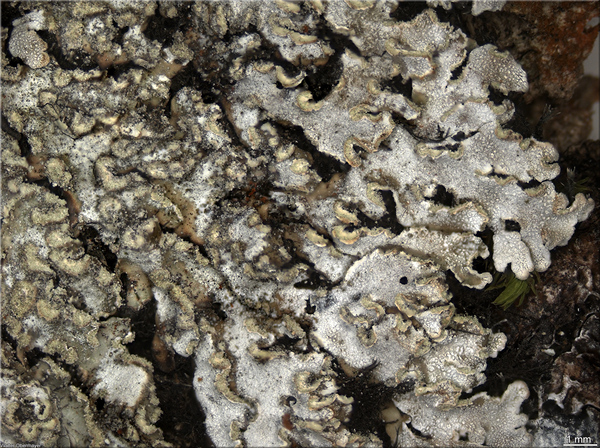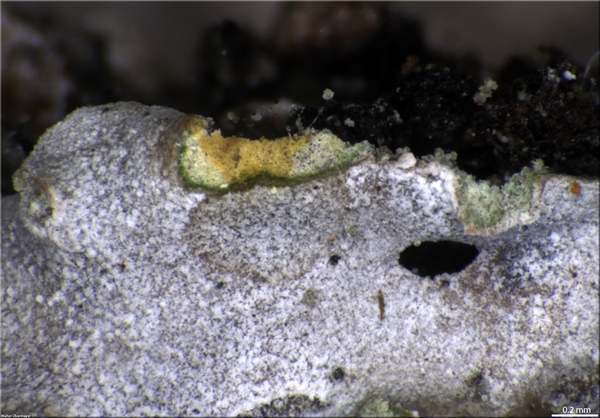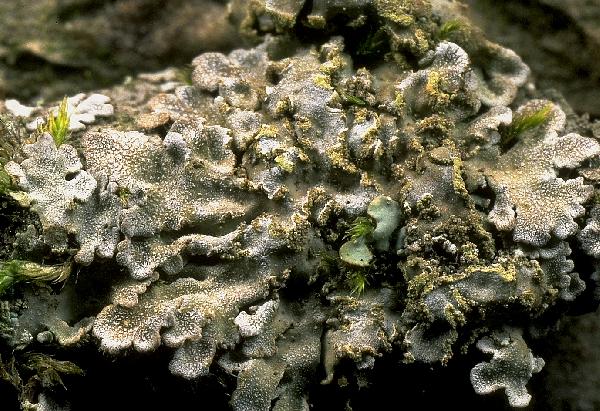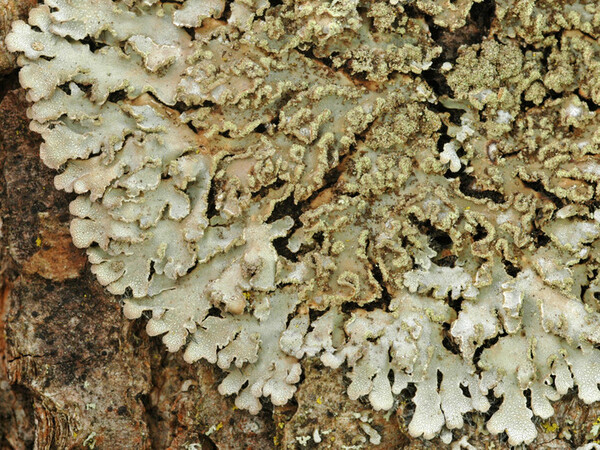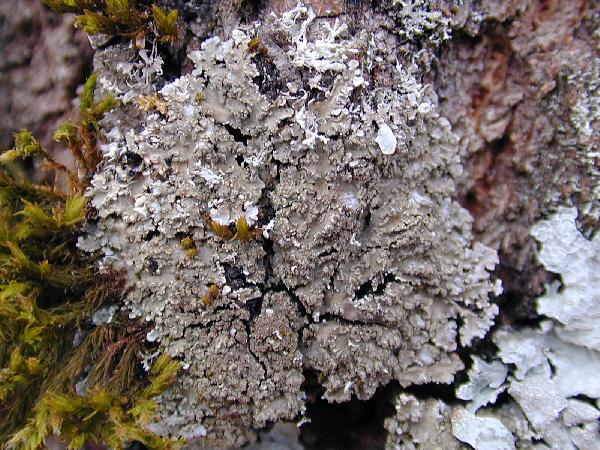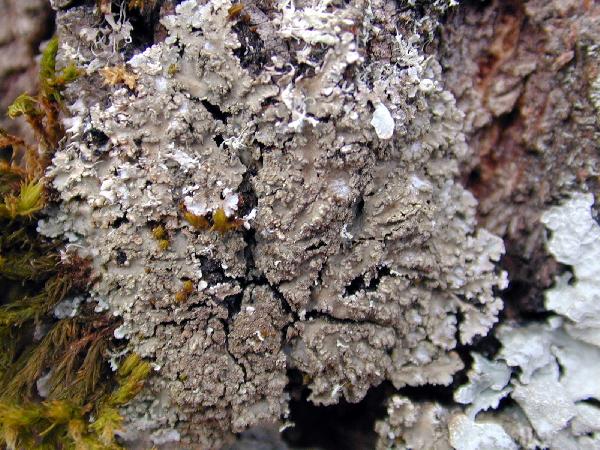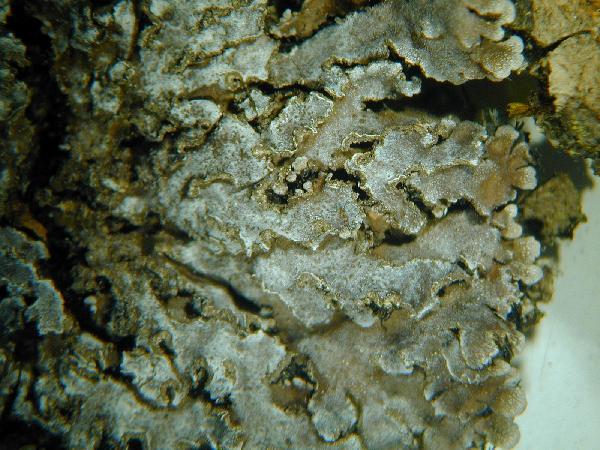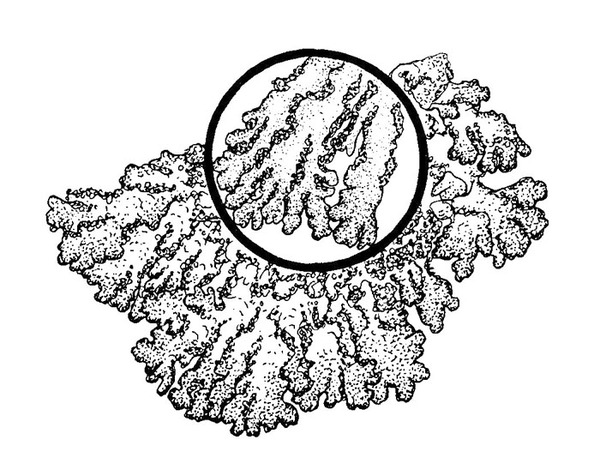Physconia enteroxantha (Nyl.) Poelt
Nova Hedwigia, 12: 125, 1966. Basionym: Physcia enteroxantha Nyl. - Flora, 56: 196, 1873.
Synonyms: Physcia enteroxanthella (Harm.) H. Olivier; Physcia leucoleiptes auct. eur. non (Tuck.) Lettau; Physcia subdetersa Nyl.
Description: Thallus foliose, heteromerous, dorsiventral, narrow-lobed, forming irregular, rarely orbicular, up to 6 cm wide rosettes. Lobes linear, discrete to partly imbricate, (0.8-)2-3 mm broad, flat to irregularly concave, grey-brown to brown, coarsely pruinose at margins and tips, with primarily marginal, elongate, dirty yellow soralia tending to become laminal in older parts, the soredia coarsely granular to almost isidioid. Lower surface pale brown at the periphery, soon darkening inward to dark brown or black, with dark, squarrose rhizines. Upper cortex paraplectenchymatous; medulla usually pale yellow, sometimes white; lower cortex irregularly prosoplectenchymatous. Apothecia rare, lecanorine, c. 2 mm across, with a sorediate thalline margin. Epithecium brown; hymenium and hypothecium colourless; paraphyses slender, simple or forked in upper part, the apical cells clavate, with a thin, dark brown cap. Asci 8-spored, clavate, the K/I+ blue tholus penetrated by a faintly amyloid apical cushion with parallel or diverging flanks, the wall K/I-, surrounded by a K/I+ blue outer layer, Lecanora-type. Ascospores 1-septate, brown, ellipsoid, (25-)28-35(-38) x (15-)16-19(-21) µm, thickened at septum but not at apices, Physconia-type. Pycnidia rare, immersed. Conidia 4-6 x c. 1 µm. Spot tests: upper cortex K-, C-, KC-, P-, UV-; medulla K+ yellowish (sometimes faintly), C-, KC+ yellow,-orange, P-; soralia K+ and KC+ yellowish or K-, KC-, UV+ orange. Chemistry: medulla and soralia with variable amounts of secalonic acid A.
Growth form: Foliose, narrow lobed
Substrata: bark and rocks
Photobiont: green algae other than Trentepohlia
Reproductive strategy: mainly asexual, by soredia, or soredia-like structures (e.g. blastidia)
Most common in areas with a humid-warm climate (e.g. most of Tyrrenian Italy)
Commonnes-rarity: (info)
Alpine belt: absent
Subalpine belt: absent
Montane belt: very rare
Dry submediterranean belt: rare
Humid submediterranean belt: rather rare
Padanian area: extremely rare
pH of the substrata:
1 2 3 4 5
Solar irradiation:
1 2 3 4 5
Aridity:
1 2 3 4 5
Eutrophication:
1 2 3 4 5
Poleotolerance:
0 1 2 3
Altitudinal distribution:
1 2 3 4 5 6
Rarity
absent
extremely rare
very rare
rare
rather rare
rather common
common
very common
extremely common
Loading data...
Occurrence data
Predictive map
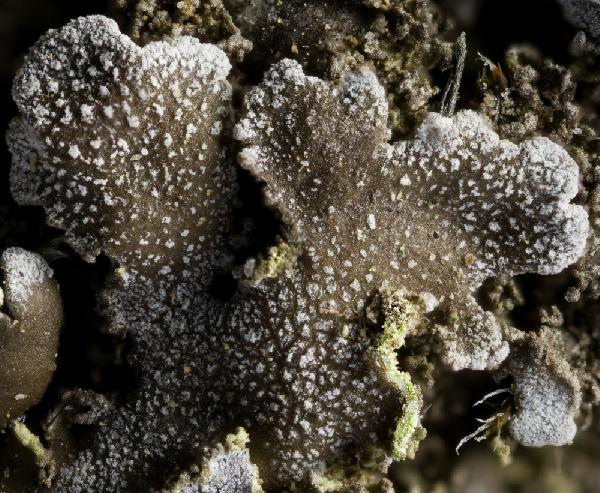
Ulrich Kirschbaum CC BY-SA 4.0 - Source: https://www.thm.de/lse/ulrich-kirschbaum/flechtenbilder
Central Europe
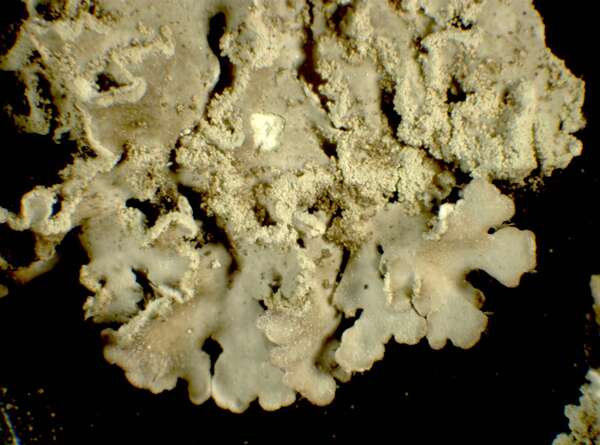
P.L. Nimis; Owner: Department of Life Sciences, University of Trieste
Herbarium: TSB (13290)
2001/12/05
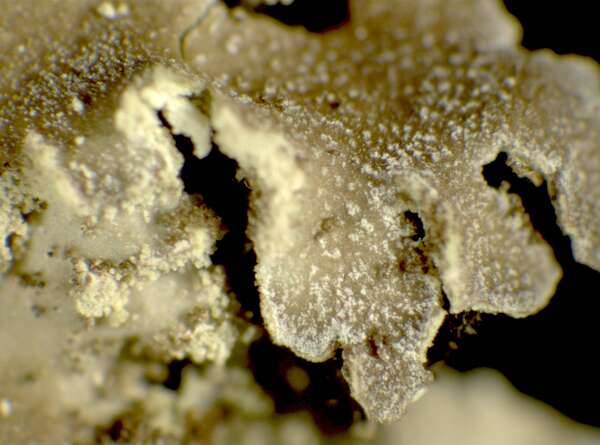
P.L. Nimis; Owner: Department of Life Sciences, University of Trieste
Herbarium: TSB (13290)
2001/12/05
detail of lobe with pruina and soralia
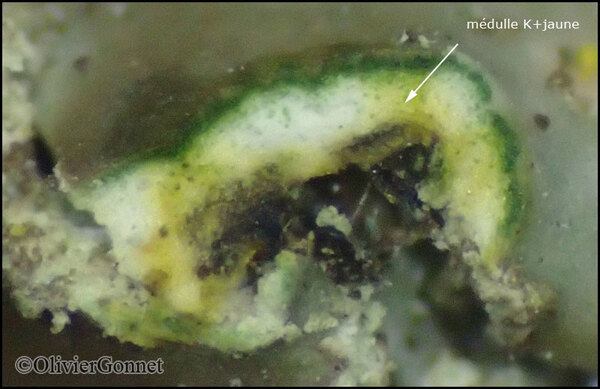
Courtesy Danièle et Olivier Gonnet - Source: https://www.afl-lichenologie.fr/Photos_AFL/Photos_AFL_P/Text_P_3/Physconia_enteroxantha.htm
France, 27/2/2019 - sur acacia - Poleymieux - Rhône
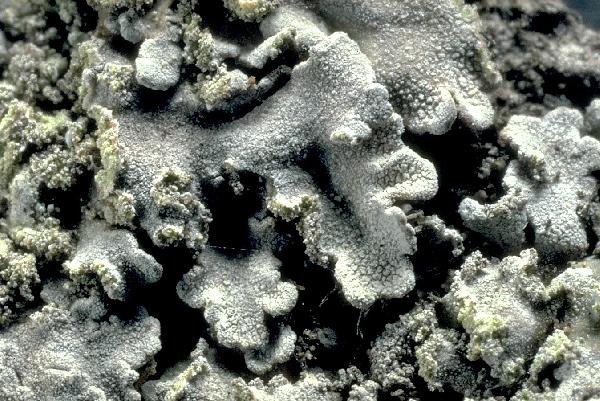
Ulrich Kirschbaum CC BY-SA 4.0 - Source: https://www.thm.de/lse/ulrich-kirschbaum/flechtenbilder
Central Europe
Growth form: Foliose, narrow lobed
Substrata: bark and rocks
Photobiont: green algae other than Trentepohlia
Reproductive strategy: mainly asexual, by soredia, or soredia-like structures (e.g. blastidia)
Most common in areas with a humid-warm climate (e.g. most of Tyrrenian Italy)
Commonnes-rarity: (info)
Alpine belt: absent
Subalpine belt: absent
Montane belt: very rare
Dry submediterranean belt: rare
Humid submediterranean belt: rather rare
Padanian area: extremely rare
pH of the substrata:
| 1 | 2 | 3 | 4 | 5 |
Solar irradiation:
| 1 | 2 | 3 | 4 | 5 |
Aridity:
| 1 | 2 | 3 | 4 | 5 |
Eutrophication:
| 1 | 2 | 3 | 4 | 5 |
Poleotolerance:
| 0 | 1 | 2 | 3 |
Altitudinal distribution:
| 1 | 2 | 3 | 4 | 5 | 6 |
Rarity
absent
extremely rare
very rare
rare
rather rare
rather common
common
very common
extremely common
Loading data...
Occurrence data
Predictive map

Ulrich Kirschbaum CC BY-SA 4.0 - Source: https://www.thm.de/lse/ulrich-kirschbaum/flechtenbilder
Central Europe

P.L. Nimis; Owner: Department of Life Sciences, University of Trieste
Herbarium: TSB (13290)
2001/12/05

P.L. Nimis; Owner: Department of Life Sciences, University of Trieste
Herbarium: TSB (13290)
2001/12/05
detail of lobe with pruina and soralia

Courtesy Danièle et Olivier Gonnet - Source: https://www.afl-lichenologie.fr/Photos_AFL/Photos_AFL_P/Text_P_3/Physconia_enteroxantha.htm
France, 27/2/2019 - sur acacia - Poleymieux - Rhône



